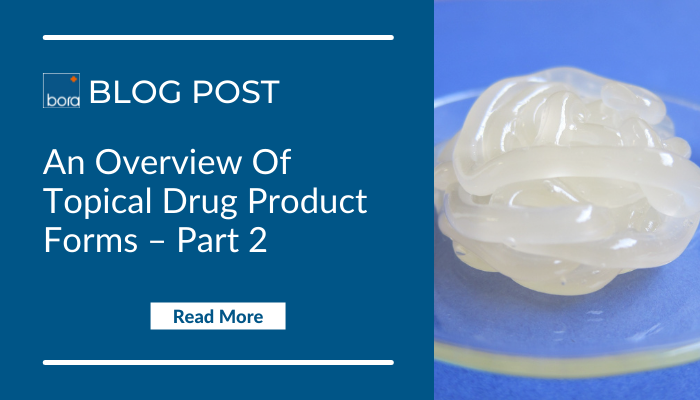In part two of these blog posts, we will discuss the various types of topical products (ointments, creams, gels, sprays, and lotions), detailing their characteristics both in terms of formulation and use.
The Challenges
As discussed earlier, there has been an increase in the development of topical drug products as a way to deliver drugs locally to those surfaces, rather than systemically. There are reduced side effects and toxicity to other organs as a result of this type of delivery compared to systemically delivered medications (oral, injectable, etc.). Choosing the right form for topical delivery of a drug can be challenging. Each form can serve a different purpose due to the API and excipients as well as the ratios of oil and water. Depending upon their oil content, different forms can be more or less desirable for treating diseases such as dry skin, rashes, or skin lesions as the drug product stays on the skin surface to protect against moisture loss.
Topical products are formulated in a base or “vehicle” which may be optimized for a particular type of skin condition or site on the body. The vehicle usually contains water, oil, alcohol or propylene glycol mixed with emulsifiers, promoters for absorption, preservatives, and fragrances.
Key Considerations
A key consideration for the form is whether the product is designed to maximize skin penetration of the API or to be moisturizing. If the product is designed for high API skin penetration, it is important to consider the thickness of the skin, the condition of the skin (intact versus damaged), the concentration of API, the molecular size of the API, hydrophilic vs lipophilic API. It is also important to remember that there may be big differences in the effectiveness of a topical medication based upon the formulation. Formulating a topical also needs to consider how the patient will comply with the application of the topical. The factors can be manipulated by considering the following:
- the total surface area that needs to be treated
- how often does the topical need to be applied
- what the “base” or “vehicle” is
- the thickness of the application
- the duration of the treatment regimen
Topical Forms
The various “form” choices can be divided into a few broad categories and we take a high-level overview of the various types of topical products outlining the characteristics of each.
Lotions are a very low viscosity solution or suspension of a drug for application to large areas of the skin. They are typically formulated with volatile materials for a cooling effect and to allow a thin film of the drug to remain on the skin surface. Lotions tend to contain a high amount of water and very little oil and some also contain a solvent like alcohol. Compared to creams, lotions have a much thinner consistency. For people with oily or acne-prone skin types, lotions can be formulated to be oil-free, alcohol, fragrances, or preservative-free. Lotions can be provided to consumers in bottles that have pumps.
 Gels are solutions of a drug in a viscous matrix that can be non-aqueous in nature if required. They tend to be made from a combination of cellulose, water, and alcohol. Viscosity enhancement can be achieved by the use of suitable polymers or viscous liquids. Typically, the drug loading of gels is low, up to 2%, but this is dependent on the solubility of the drug in the matrix. Gels have a higher absorption rate and offer skin hydration without any residue that leaves excess oil on the skin. Gels are not ideal for patients who have sensitive or dry skin since this form may cause irritation and excess dryness.
Gels are solutions of a drug in a viscous matrix that can be non-aqueous in nature if required. They tend to be made from a combination of cellulose, water, and alcohol. Viscosity enhancement can be achieved by the use of suitable polymers or viscous liquids. Typically, the drug loading of gels is low, up to 2%, but this is dependent on the solubility of the drug in the matrix. Gels have a higher absorption rate and offer skin hydration without any residue that leaves excess oil on the skin. Gels are not ideal for patients who have sensitive or dry skin since this form may cause irritation and excess dryness.
Creams are viscous emulsions, usually oil in water and are usually in equal parts of water to oil. Creams are used mostly with lipophilic compounds that dissolve readily in the oily phase. As with gels, the drug loading tends to be low and is dependent on the solubility of the drug in the oily phase. This is typically less than 30% of the cream so drug loading can be challenging unless drug lipophilicity is high. Creams tend to be better absorbed through the skin due to their higher water content. Creams too are good for large treatment areas. Creams are typically provided in jars or tubes because they tend to be more viscous.
Ointments are extremely viscous suspensions of drug particles in a “waxy” paste. Generally, there is no need for preservatives, so this cuts down on contact allergies. Ointments can contain excipients such as paraffin, animal fats, emulsifying wax, beeswax, cetrimide, macrogols, or vegetable oils. Of all the topical forms, ointment contains the highest oil content. Ointments are used when high drug loading is required. They can be challenging to apply evenly and frequently have a poor appearance and greasy feel that leads to compliance issues by patients. One of their key performance factors is to have an occlusive effect. This means they are not absorbed quickly and stay on the surface of the skin, thus keeping moisture trapped in the skin. Common excipients in ointments include petroleum products and/or mineral oil. It is common to see antibiotics (for treating infections like mupirocin) or corticosteroids (for treating psoriasis) formulated into an ointment so they don’t evaporate quickly and achieve better skin penetration.
Sprays are a means of applying very low viscosity systems such as lotions and creams whose consistency has been lowered to the point that they are more typically referred to as an emulsion. Sprays are ideal for mucosal surfaces like nasal passages and large dermal surfaces.
Dosage Form Considerations to Improve Patient Outcomes
In summary, there are a variety of factors that should be considered in selecting the appropriate topical formulation for a generic drug or new chemical entities. Choosing the right topical form depends on key factors such as patient compliance, drug loading, surface area to cover, and formulation issues. It is important to consider these factors when selecting the appropriate form. Many of these forms have differing ratios of water to oil and thus viscosity is vastly different. Ointments contain the most oil, followed by creams with some oil, while lotions and gels contain more water. For wet or oozy skin conditions, creams and lotions are the most suitable options. For dry, scaly skin conditions or where an occlusive type of form is needed, ointments are most appropriate. For inflamed skin, creams or ointments are the best options. And finally, for skin that is cracked or has open sores, avoid alcohol and acidic preparations.
 Guest post by Dr. David Barnes
Guest post by Dr. David Barnes
Dr. David Barnes is the founder, chief executive officer, and chief scientific officer of Velesco Pharmaceutical Services. Dave’s expertise is in drug formulation and drug product development.



